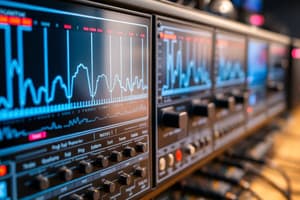Podcast
Questions and Answers
What is the primary goal of using ensemble averaging in digital computer software algorithms?
What is the primary goal of using ensemble averaging in digital computer software algorithms?
- To decrease the computational power required for data analysis
- To reduce the signal strength of the observations
- To improve the signal-to-noise ratio of the averaged data (correct)
- To increase the noise of the individual observations
What is the relationship between the noise of a single observation and the noise of n observations?
What is the relationship between the noise of a single observation and the noise of n observations?
- The noise of n observations is proportional to √n (correct)
- The noise of n observations is inversely proportional to n
- The noise of n observations is proportional to n^2
- The noise of n observations is equal to n times the noise of a single observation
What is the formula for the signal-to-noise ratio of the averaged data?
What is the formula for the signal-to-noise ratio of the averaged data?
- S/N = S1/N1
- S/N = n S1/N1
- S/N = √n S1/N1
- S/N = S1/√n N1 (correct)
What is the purpose of summing successive sets of data point by point in ensemble averaging?
What is the purpose of summing successive sets of data point by point in ensemble averaging?
What is the assumption about the noise of individual observations in ensemble averaging?
What is the assumption about the noise of individual observations in ensemble averaging?
Study Notes
Software Method
- High-speed microprocessors and digital computer software algorithms are used in software method.
Ensemble Averaging
- Successive sets of data are summed point by point and each point is averaged in ensemble averaging.
- The noise of one observation (set) is denoted as N1.
- The noise of n observations is equal to the square root of n multiplied by N1 (√n N1).
- The signal-to-noise ratio (S/N) for the average is equal to the square root of n multiplied by S1 divided by N1, where S1 is the signal for one observation (S/√n = S1/√n N1).
Studying That Suits You
Use AI to generate personalized quizzes and flashcards to suit your learning preferences.
Description
Learn about software methods used in signal processing, including ensemble averaging and its application in reducing noise and improving signal-to-noise ratio.




